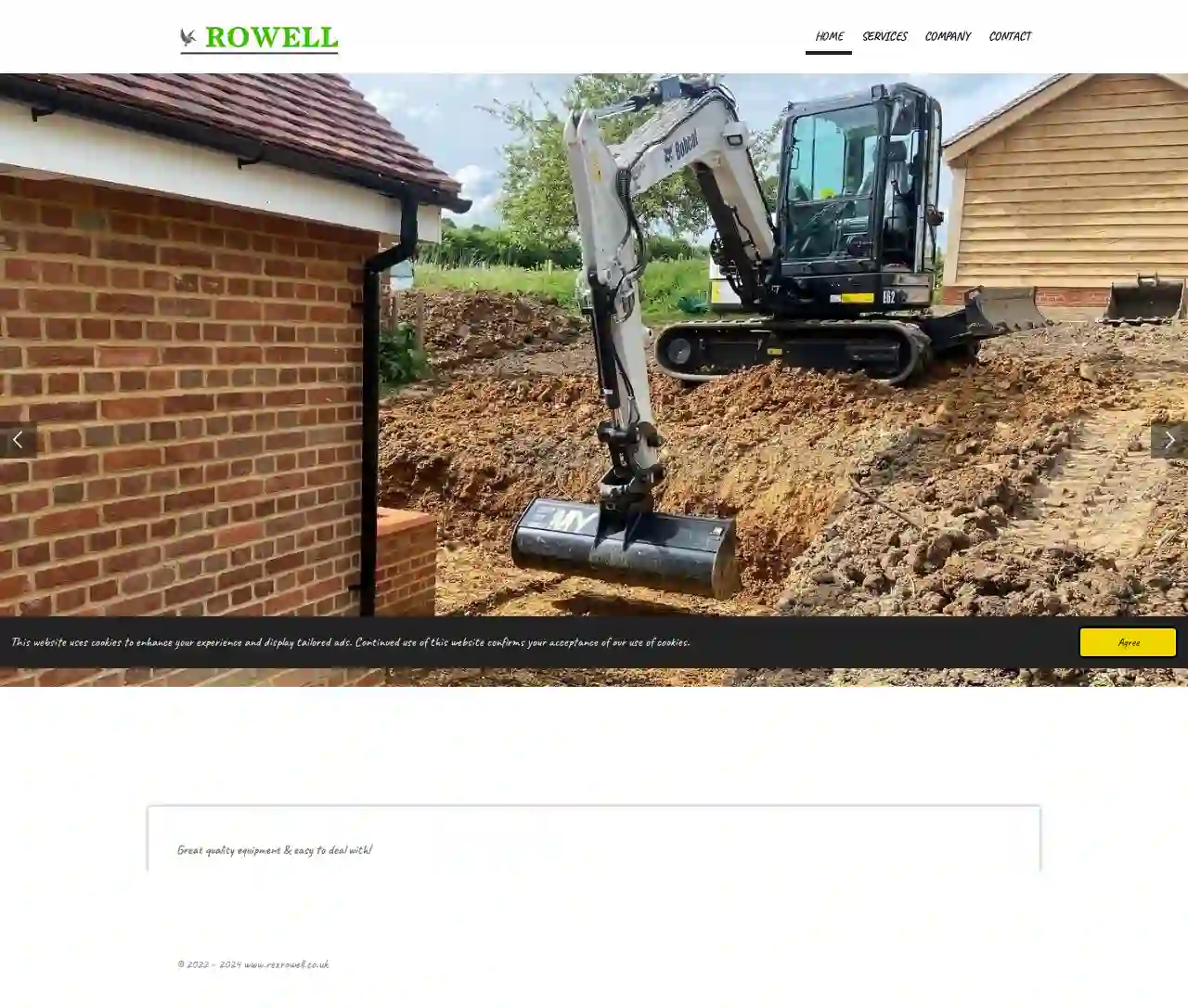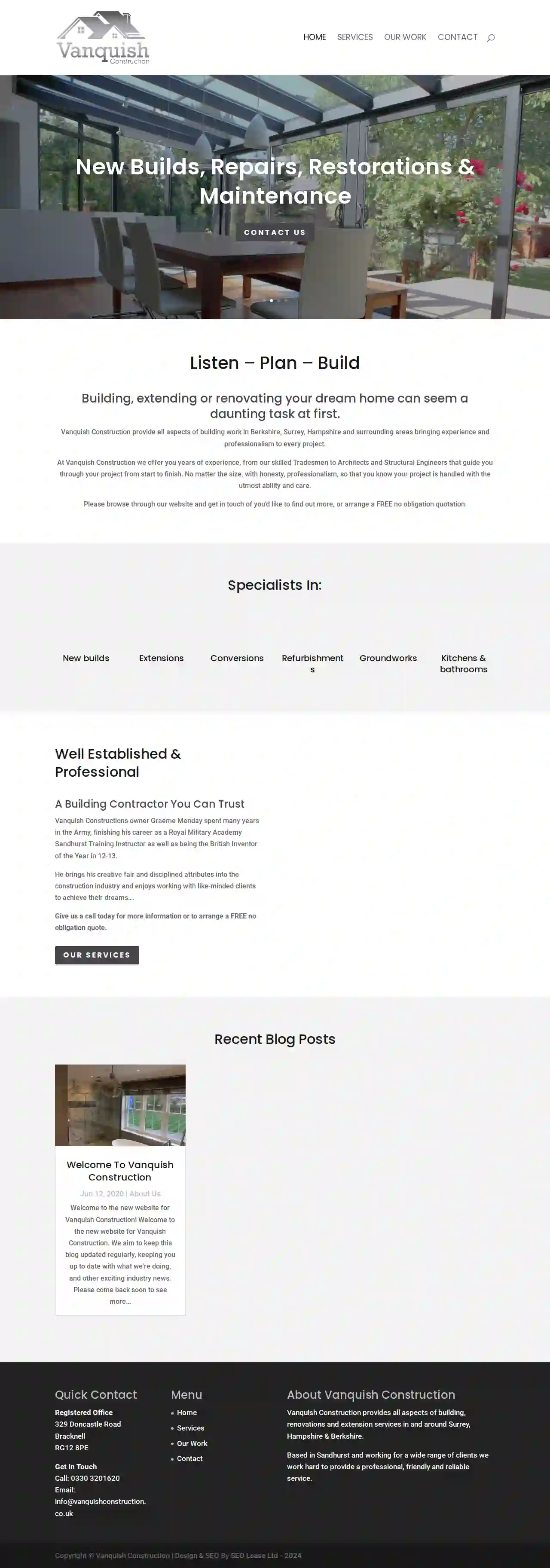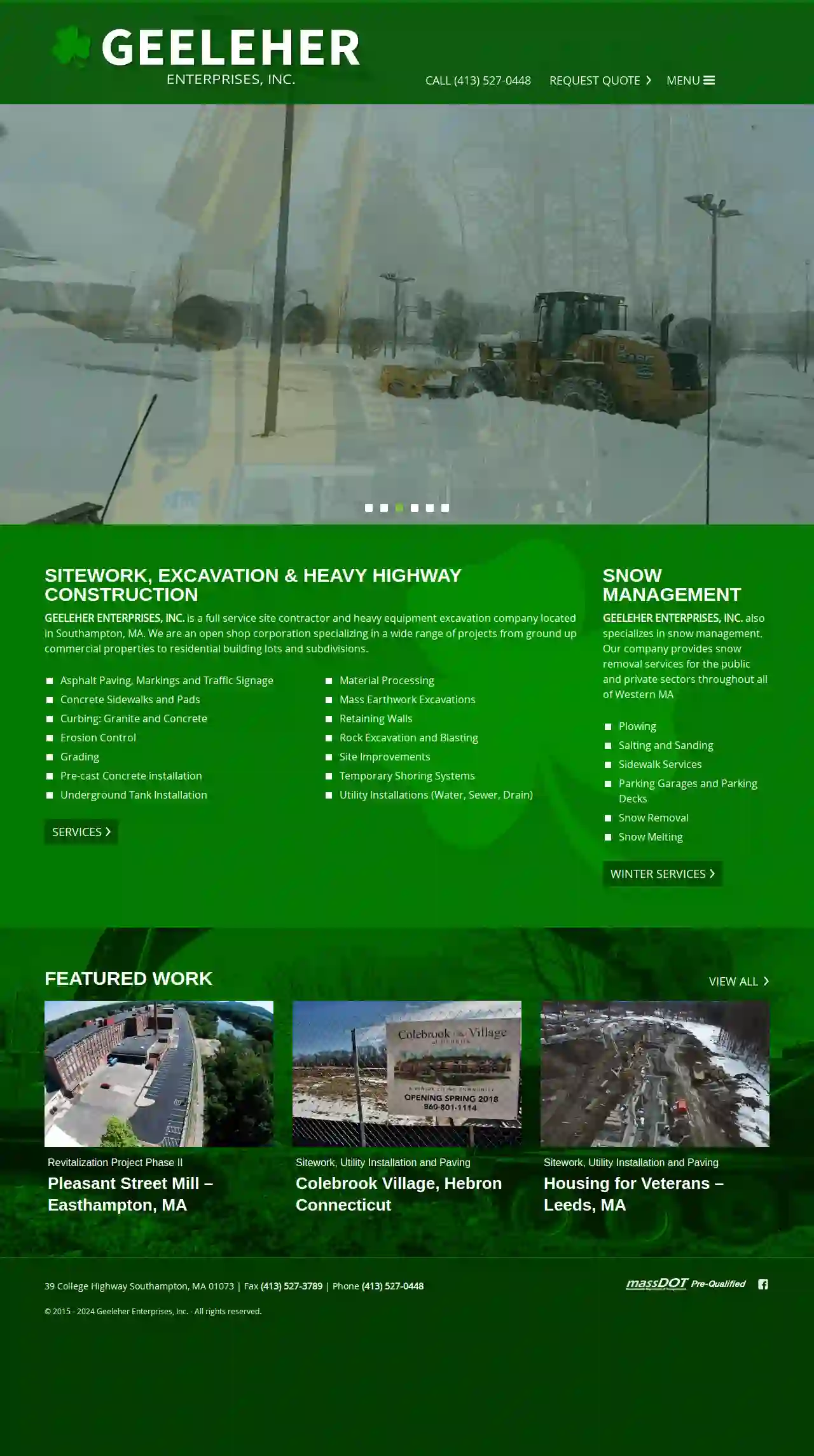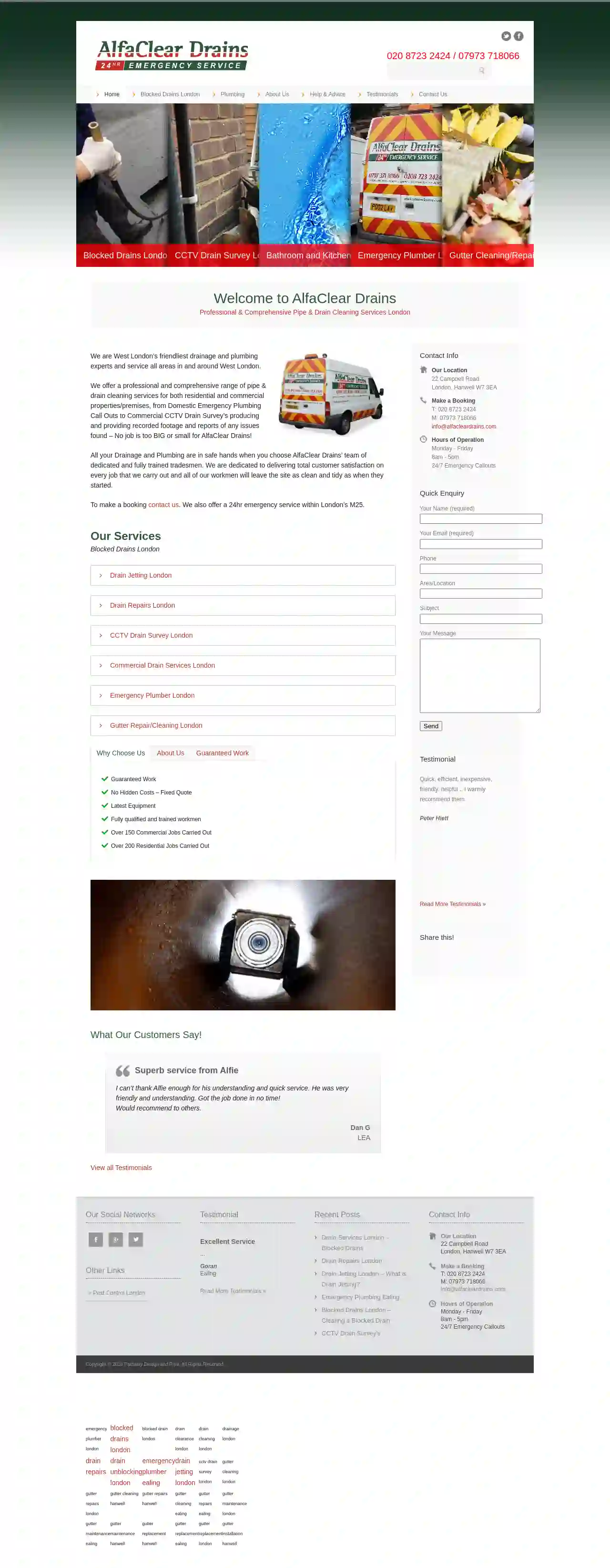Excavation Contractors Eton
Find the best Excavation Companies in Eton
Receive up to 3 Digging Contractors quotes for your project today! Compare profiles, reviews, accreditations, portfolio, etc... and choose the best deal.

Ebbsfleet Contractors Ltd
31 reviewsFleet, GBAbout Kent Building Network Your building project deserves the best … Highest standard project management and workmanship Carefully matched to existing building style and materials Compliant with building regulations and codes of practice. Members of the Kent Building Network can undertake any construction project in Kent, and nothing is too small or too complicated. Be it renovations, woodwork, bathroom and kitchen fitting, extensions and conversions, plumbing or joinery, our approved panel of building contractors are here to build your perfect home using the latest designs, highest quality materials and all of our expertise! Our experienced builders will complete each stage of your domestic or commercial project, from the conception of the plumbing and heating system to the decorations to complicated electrical wiring. If you are looking for local builders in Kent, get in touch today. Our members are competitively priced with an excellent track record of customer satisfaction.
- Services
- Why Us?
- Gallery
Get Quote
Globic Groundworks
Camp Sewage Disposal Works, Camp Farm Road, Aldershot, GU11 2NS, GBWelcome to Globic Groundworks Globic Groundworks has been providing a comprehensive range of groundworks services for the past 50 years. From all types of roadworks, including driveway repair and resurfacing, to excavation, and drain and sewer unblocking, cleaning and repair, Globic Groundworks possesses the experience, equipment, and expertise to tackle any project, regardless of size. We cater to a diverse clientele, including local authorities, housing associations, schools, hospitals, commercial businesses, and private homeowners. Our unwavering commitment is to deliver high-quality services that meet the highest standards, exceeding our clients' expectations. For a tailored solution that precisely aligns with your specific requirements, contact our Aldershot office toll-free at 01252 310515.
- Services
- Why Us?
- Accreditations
- Testimonials
- Gallery
Get Quote
Guildford Landscapes Ltd
4.935 reviews7 Burnt hill, Plaistow Road, Godalming, GU8 4PG, GBGuildford Landscapes Ltd We are a family-run business with over 20 years of experience in the landscaping and paving industry. We are committed to providing our clients with the highest quality workmanship and customer service. We offer a wide range of services to meet your needs, from simple garden maintenance to complete landscaping projects. We are also proud to be approved members of the following associations: Our Services We offer a wide range of services to meet your needs, from simple garden maintenance to complete landscaping projects. We are also proud to be approved members of the following associations: Paving Driveways Patios Fencing Decking Groundworks Gravel Drives Tarmac Driveways Paths Block Paving Turfing & Lawns Indian Sandstone
- Services
- Why Us?
- Testimonials
- Gallery
Get Quote
J Searle Contractors Ltd
51 reviewsThe Pines, Green Lane East, Guildford, GU3 2JL, GBWelcome To J Searle Contractors Ltd J Searle Contractors are a leading groundworks company, offering a comprehensive range of services to both domestic and commercial clients across the South-East regions. We have been delivering our services across the South-East for over 3 generations. Professional Groundwork Specialists At J Searle Contractors Ltd, we take pride in being a leading provider of comprehensive groundwork services tailored to meet the diverse needs of our clients. With a rich legacy of expertise and commitment, we offer a range of groundwork solutions, ensuring precision, safety, and environmental responsibility during every project. Our Services J.Searle Contractors take pride in our reputation as being a reliable and trustworthy groundworks company with a focus on health and safety and environmental responsibility. We have been delivering our services across the South-East for over 3 generations.
- Services
- Why Us?
- Gallery
Get Quote
Rex Rowell Groundworks
57 reviewsAldershot, GBPutting Safety First Home Safe Every Day Established in 2016, Rex Rowell is a fully insured groundwork and plant hire company operating throughout Surrey and Hampshire. We are committed to providing a professional and reliable service, with a focus on safety and quality. Our team of experienced operators and skilled groundworkers are dedicated to delivering exceptional results on every project. We offer a wide range of services, including: Plant Hire Operator & Excavator Hire Trial Hole Digging Soak Away Test Pitts Foundations Ditching Archaeological Digging Groundwork Site Clearance Bulk Excavation Ponds & River Banks Soak Away Instillation Drainage Treatment plants Construction Car Parks Retaining Walls & Structures Roads & Tracks Driveways Concrete Slabs We are fully insured to £5 million and are CPCS & CSCS compliant. We are also proud to be a member of the Construction Industry Scheme (CIS). Our commitment to safety is paramount. We have a comprehensive health and safety policy in place and all our operators are fully trained and qualified. We are also committed to environmental sustainability and strive to minimize our impact on the environment. We are confident that we can provide you with the highest quality service and workmanship. Contact us today to discuss your project requirements.
- Services
- Why Us?
- Testimonials
- Gallery
Get Quote
Vanquish Construction ltd
329 Doncastle Road, Bracknell, RG12 8PE, GBBuilding, extending or renovating your dream home can seem a daunting task at first. Vanquish Construction provide all aspects of building work in Berkshire, Surrey, Hampshire and surrounding areas bringing experience and professionalism to every project. At Vanquish Construction we offer you years of experience, from our skilled Tradesmen to Architects and Structural Engineers that guide you through your project from start to finish. No matter the size, with honesty, professionalism, so that you know your project is handled with the utmost ability and care. Please browse through our website and get in touch of you’d like to find out more, or arrange a FREE no obligation quotation. Well Established & Professional A Building Contractor You Can Trust Vanquish Constructions owner Graeme Menday spent many years in the Army, finishing his career as a Royal Military Academy Sandhurst Training Instructor as well as being the British Inventor of the Year in 12-13. He brings his creative fair and disciplined attributes into the construction industry and enjoys working with like-minded clients to achieve their dreams…. Give us a call today for more information or to arrange a FREE no obligation quote.
- Services
- Why Us?
- Gallery
Get Quote
Connell Oliver & Son Ltd
3.938 reviewsZanrose House, Perivale Park, Horsenden Lane South, Greenford, UB6 7RH, GBOliver Connell & Son: Specialist Subcontractors in West London Established in 1974 by Oliver and Pat Connell, Oliver Connell & Son began as a small family-run groundworks company. Over the years, they have consistently grown and thrived, becoming one of the most established RC Frame and Groundworks subcontractors in London, with an annual turnover exceeding £150 million. Oliver Connell & Son Ltd has left a significant mark on the southeast landscape. From the iconic ‘Eagle’ building on London's City Road and Fetter Place in the City, showcasing the high architectural finish achieved with their 13-story panoramic glass lifts, to the Marriott Lingfield Hotel, the recently opened Cambridge Ibis Hotel, and countless residential units throughout the region, their work is evident. Oliver Connell & Son offers clients suitable construction solutions thanks to their in-house labor, formwork, plant, and machinery, all supplied from their depot and head office located near central London.
- Services
- Why Us?
- Testimonials
- Gallery
Get Quote
Maritime Case Ltd
4.616 reviews81 Greenview Drive, Hanwell NB, Hanwell, E3C 0E4, GBAbout Us Maritime Case Ltd. was appointed the distributor of Case Construction Equipment for New Brunswick and Prince Edward Island in 2007. Maritime Case is a family-owned business whose roots stem from the small town of Florenceville, New Brunswick. The family’s corporate portfolio streams across many industries including: farming, produce sales, agriculture equipment sales, transportation and commercial real estate. Keeping in line with the family’s values, Maritime Case strives for an optimal customer service experience through knowledgeable and friendly staff, timely responses, minimal downtime and forging long lasting relationships. Meet Some of the Team David Harrison Parts Manager [email protected] We Are Hiring APPLY NOW
- Services
- Why Us?
- Our Team
- Gallery
Get Quote
Geeleher Enterprises Inc
53 reviews39 College Highway, Southampton, 01073, GBSITEWORK, EXCAVATION & HEAVY HIGHWAY CONSTRUCTION GEELEHER ENTERPRISES, INC. is a full service site contractor and heavy equipment excavation company located in Southampton, MA. We are an open shop corporation specializing in a wide range of projects from ground up commercial properties to residential building lots and subdivisions.
- Services
- Why Us?
- Gallery
Get Quote
AlfaClear Drains
4.619 reviews22 Campbell Road, London, W7 3EA, GBWelcome to AlfaClear Drains Professional & Comprehensive Pipe & Drain Cleaning Services London We are West London’s friendliest drainage and plumbing experts and service all areas in and around West London. We offer a professional and comprehensive range of pipe & drain cleaning services for both residential and commercial properties/premises, from Domestic Emergency Plumbing Call Outs to Commercial CCTV Drain Survey’s producing and providing recorded footage and reports of any issues found – No job is too BIG or small for AlfaClear Drains! All your Drainage and Plumbing are in safe hands when you choose AlfaClear Drains’ team of dedicated and fully trained tradesmen. We are dedicated to delivering total customer satisfaction on every job that we carry out and all of our workmen will leave the site as clean and tidy as when they started. To make a booking contact us. We also offer a 24hr emergency service within London’s M25.
- Services
- Why Us?
- Testimonials
- Gallery
Get Quote
Over 13,059+ Excavation Businesses registered
Our excavation contractors operate in Eton and beyond!
ExcavationHQ has curated and vetted Top Excavation Contractors arround Eton. Find a top & reliable pro today.
Frequently Asked Questions About Excavation Contractors
- Clear the Area: Remove any obstacles, including vehicles, outdoor furniture, landscaping features, or structures, from the excavation zone and surrounding area.
- Mark Existing Features: Identify and mark underground utilities, septic tanks, sprinkler systems, or other buried elements you want to protect.
- Protect Landscaping: Use tarps or fencing to shield trees, shrubs, gardens, or other landscaping elements from damage.
- Provide Access: Ensure the excavation contractor has clear access to the work area, including gates wide enough for equipment.
- Discuss Logistics: Coordinate with the contractor regarding parking arrangements, material delivery, and any special instructions or concerns you might have.
- Trench Collapses: Unstable trench walls can cave in, posing a severe risk to workers. Proper shoring and sloping are crucial safety measures.
- Utility Damage: Striking underground utilities (gas, water, electric) can cause leaks, explosions, or electrocution. Accurate utility locates and careful digging are essential.
- Falling Objects: Materials or equipment falling into excavations can injure workers. Securing work areas and using appropriate safety gear is vital.
- Equipment Accidents: Operating heavy machinery involves risks of rollovers, collisions, or mechanical failures. Trained operators and proper equipment maintenance are critical.
- Environmental Hazards: Excavated soil might contain hazardous materials (asbestos, lead). Proper testing and disposal procedures are necessary.
- Sloped Property: Your property has a significant slope, making it prone to soil erosion or landslides.
- Creating Usable Space: You want to level off a sloped area to create a flat surface for patios, gardens, or other outdoor spaces.
- Preventing Damage: Erosion is threatening existing structures, driveways, or walkways.
- Landscaping Features: You're incorporating tiered gardens, raised beds, or other landscaping elements requiring soil retention.
- Excavators: Versatile machines with a bucket, arm, and rotating cab for digging, lifting, and moving earth.
- Backhoes: Similar to excavators but with a digging bucket on the back and a loader bucket on the front, ideal for trenching and smaller excavations.
- Bulldozers: Powerful machines with a large blade for pushing earth, clearing land, and leveling surfaces.
- Skid Steers: Compact and maneuverable loaders with various attachments (buckets, forks) for digging, loading, and grading in tight spaces.
- Trenchers: Specialized machines for digging narrow trenches for utilities.
- Dump Trucks: Vehicles for hauling excavated material to disposal sites.
How do I prepare my property for excavation?
What are the risks associated with excavation?
How do I know if I need a retaining wall?
What equipment is used for excavation?
How do I prepare my property for excavation?
- Clear the Area: Remove any obstacles, including vehicles, outdoor furniture, landscaping features, or structures, from the excavation zone and surrounding area.
- Mark Existing Features: Identify and mark underground utilities, septic tanks, sprinkler systems, or other buried elements you want to protect.
- Protect Landscaping: Use tarps or fencing to shield trees, shrubs, gardens, or other landscaping elements from damage.
- Provide Access: Ensure the excavation contractor has clear access to the work area, including gates wide enough for equipment.
- Discuss Logistics: Coordinate with the contractor regarding parking arrangements, material delivery, and any special instructions or concerns you might have.
What are the risks associated with excavation?
- Trench Collapses: Unstable trench walls can cave in, posing a severe risk to workers. Proper shoring and sloping are crucial safety measures.
- Utility Damage: Striking underground utilities (gas, water, electric) can cause leaks, explosions, or electrocution. Accurate utility locates and careful digging are essential.
- Falling Objects: Materials or equipment falling into excavations can injure workers. Securing work areas and using appropriate safety gear is vital.
- Equipment Accidents: Operating heavy machinery involves risks of rollovers, collisions, or mechanical failures. Trained operators and proper equipment maintenance are critical.
- Environmental Hazards: Excavated soil might contain hazardous materials (asbestos, lead). Proper testing and disposal procedures are necessary.
How do I know if I need a retaining wall?
- Sloped Property: Your property has a significant slope, making it prone to soil erosion or landslides.
- Creating Usable Space: You want to level off a sloped area to create a flat surface for patios, gardens, or other outdoor spaces.
- Preventing Damage: Erosion is threatening existing structures, driveways, or walkways.
- Landscaping Features: You're incorporating tiered gardens, raised beds, or other landscaping elements requiring soil retention.
What equipment is used for excavation?
- Excavators: Versatile machines with a bucket, arm, and rotating cab for digging, lifting, and moving earth.
- Backhoes: Similar to excavators but with a digging bucket on the back and a loader bucket on the front, ideal for trenching and smaller excavations.
- Bulldozers: Powerful machines with a large blade for pushing earth, clearing land, and leveling surfaces.
- Skid Steers: Compact and maneuverable loaders with various attachments (buckets, forks) for digging, loading, and grading in tight spaces.
- Trenchers: Specialized machines for digging narrow trenches for utilities.
- Dump Trucks: Vehicles for hauling excavated material to disposal sites.
